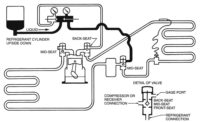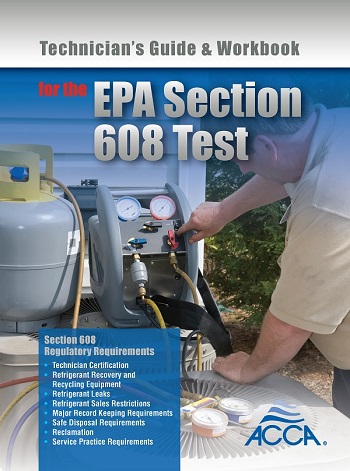Bob and Tim are on their way to a new job and discussing what the work order said.
Tim tells Bob that the customer is new and the work order says the thermostat is set at 74°F while the thermometer reads 78°F, and unit is running full time. The customers are uncomfortable.
“What do you suspect we may run into?” Tim asked. “It sounds as though the unit is operating but not up to capacity.”
“There are a lot of speculative homes built in this area, and the design engineers use 95°F outdoor temperature as their design criteria,” Bob explained. “Usually there are variables in the construction and measurements that give the system a little excess capacity. But if the design criteria falls exactly on 95°F, and the outdoor temperature goes up above 95° for a long period of time, such as all day, the unit will run continuously but will not hold the indoor temperature inside when the outside temperature is above the design temperature. For example, if this house we’re going to has a design criterion of 95°, then today the inside temperature may rise above the 75° indoor design temperature. It is 98°F outside today so I would expect the indoor temperature to go above the indoor design temperature of 75°F. We need to check the unit and make sure it is operating up to capacity. And if it is doing all it can, the only thing we can do is possibly reduce the load on the house”.
“What can we do?” Tim asked.
“Let’s get to the house and look at the way it’s built, how it faces the sun, and then we may make some suggestions to see if we can help the situation,” Bob replied.
They arrived and looked over the system to find the house was facing south with most of the windows on the south side. The house had a hip roof and a very shallow attic. They looked over the air conditioning equipment and found that it seemed to be operating at maximum capacity. The suction line leaving the evaporator was nice and cold, the liquid line was nice and warm, but not hot, indicating that sub cooling was taking place in the condenser. They removed the electrical panel and checked the amperage to the compressor and it was running full load according to the nameplate.
“It seems as though the air conditioner is doing all that it can do,” Bob said. “If we could lower the head pressure, we would get a little more capacity out of the unit and that would help. If we could remove some of the heat load on the house, we would not need quite as much capacity. Between the two of them, we can probably bring the unit capacity and the load on the house closer together and give these people some comfort. With the sun shining on the windows on the south side of the house, we might propose to the homeowner that they install some awnings to reduce the sun load on the structure.
Tim asked, “How can we lower the head pressure on the condensing unit?”
“We can go to the local irrigation store or hardware store, buy some small misting type nozzles, and connect up a fine mist spray into the airstream entering the condenser,” Bob explained. “This would be temporary, and we will have to show the homeowner how to turn it off in the evening and operate it only in the hottest part of the day. (Figure 1)
They went to the local hardware store and got a few mist nozzles — one for each side of the condenser — and a spray type soaker hose for the roof of the house. After bringing them back to the house, they stretched the soaker hose down the spine of the house and turned it on. It created a slight mist down the roof of the house which will take part of the roof load off the structure.
They then installed the misters on the condensing unit and turned them on.
“I don’t want to put gauges on the system to check the pressures, but we can use the infrared thermometer and see how the temperature of the liquid line and suction line respond,” Bob said. “The suction line at the condensing unit was 65° and the liquid line temperature was 113°F before we turned on the mister. Let’s see what they are reading now.”
Tim took the readings and said, “The suction line temperature is now reading 55° and the liquid line temperature is now reading 100°. The compressor amperage has reduced by several amps, so the compressor is not working as hard as it was and the system is operating at lower pressures, so I believe that’s going to equate to more capacity”.
Bob and Tim went in and talked to the retired couple who owned the house.
“We have installed a very simple manually operated water spray system on your roof and on your air conditioning unit outdoors,” Bob explained to the owners. “You should operate them during the heat of the day in this really hot weather. When the weather cools down below 95° you should be able to turn those systems off and the system will still maintain your indoor comfort range of conditions. This is going to use a little bit of water but will be worth it for your indoor comfort. I would also suggest that you contact a company and have awnings put on several of your front facing windows to block the southern sun from hitting the inside of your house. This will reduce your utility bill by some, but you will be able to have comfort during the entire cooling season. You might want to consider planting a fast-growing shade tree or two in your front yard to block the sun during the summer months.”
As they were riding away from the job, Bob explained to Tim, “There are many systems in this area that are sized right on 95°F, and there are many owners in this area who are unhappy on these extra hot days. It is best to have a system sized right on the design temperature for operating purposes. The equipment operates much more efficiently if it operates over long periods of time during hot weather. Most equipment doesn’t operate at full capacity except a few days out of the year for a few hours on these hot days, so many designers have started lowering the unit capacity compared to the home cooling load to get longer running hours out of the equipment. Most of the time, the outdoor temperature is below the design temperature for the summer conditions. We have more 80 and 85° days than we have 95° days, and very few days or hours over 95°. If the system is designed exactly for 95°, and the house load is exactly matched to the system, the house temperature will go above thermostat setpoint for several hours a day, but will drop back to normal during the evening. What we did was give this one customer a little bit of relief.”
“I think I would like to have a system with more capacity,” Tim said.
“That means your system will be oversized the majority of the time that it runs, and it will be operating at less than maximum capacity and efficiency the majority of the time,” Bob said. “It is a trade-off to have a slightly oversized system, and you pay for it in operating conditions and energy consumption. But it is worth it to some people who can afford it.”
Publication date: 8/20/2018
Want more HVAC industry news and information? Join The NEWS on Facebook, Twitter, and LinkedIn today!









